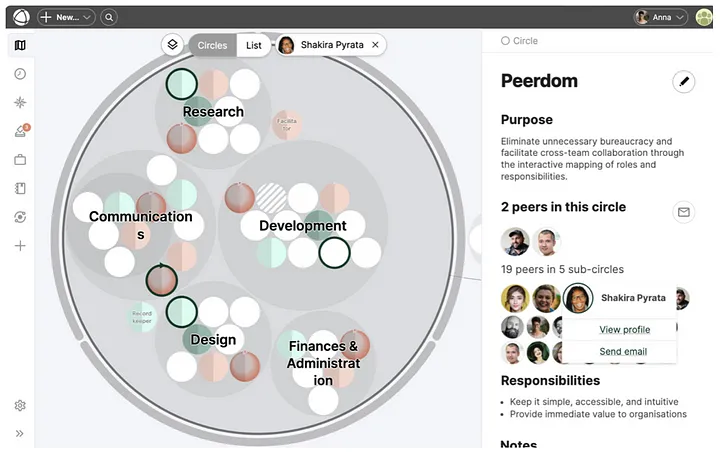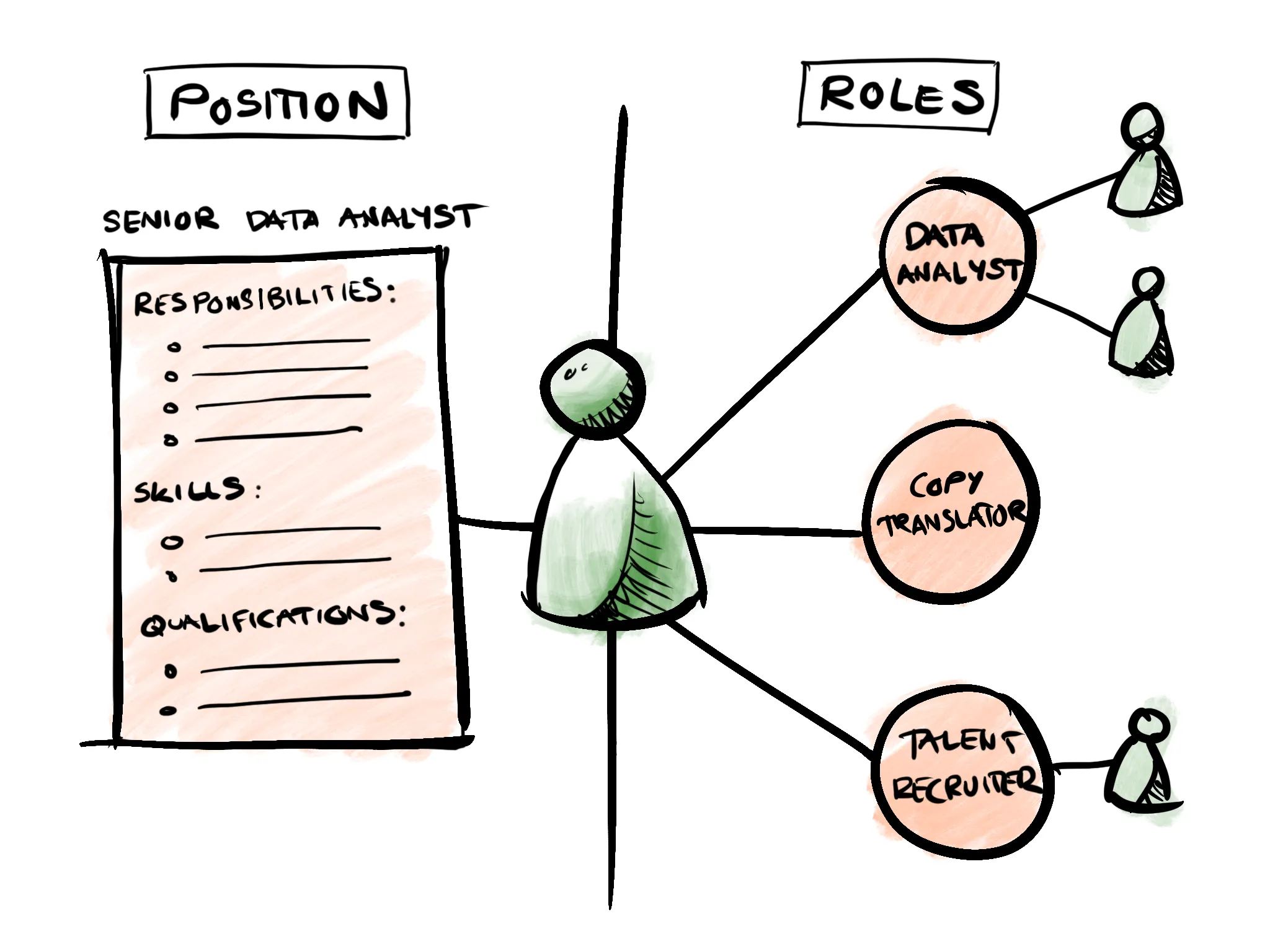Three lessons from assisting organizational transformations
After 3 years of being a Peerdom Companion, Marc Wethmar reflects on using Peerdom to enable organizational transformations with his clients.
It all started with a phone call with Bastiaan van Rooden, who like me, is Dutch. I had read an interview with him in my daily newspaper, where he spoke about sharing governance in his self-managed company Nothing. Bastiaan co-created a tool to visualise the roles of co-workers at Nothing and later realised that other organisations could also take advantage of it. Peerdom was born. We quickly became companions and friends.
Several of my clients have adopted Peerdom and found it very helpful. I’d like to share a couple of insights and learnings I’ve had over these past 3 years, in the form of snippets.
The power of visualisation, transparency, and mindset
After supporting various transformations where Peerdom was involved, I’ve come to realise how timing plays an important role when introducing Peerdom. Without neurological proof, I began to see a pattern: co-workers who see their organisation visualised by Peerdom form an important, new mental framing. The sooner that employees affected by the transformation see their different roles visualised, the quicker they understand the new direction of the organisation and its values.

By literally seeing their organisation as a collection of roles instead of positions (as visualised by classic org charts with several management layers above and the employees below), my assumption is that something happens in the brain of the viewer when seeing his/her organisation as roles in full transparency. Peerdom helps to visualize how people work together, so they quickly and reliably “get the message” that everyone can become a leader in his/her specified roles. They more easily adopt the mindset that Leadership is not bound to leading people and departments but can also be done by any and everybody in his or her roles within their associated accountabilities.
I’ve also experienced on several occasions with clients that the Peerdom visualisation helps people more easily shift to the mindset of an organisation being a living organism with resourceful humans rather than a machine with (human) resources. They see the connections inherent to collaboration, the interdependence within an organisation. Peerdom helps visualize this inter-connectedness, which provides a different and more attractive perspective as compared to silo-based org-charts.

Roles instead of positions
The core of Peerdom is the visualisation of roles. I’d like to share an experience while working with a department within a Big Pharma Corporation based in Germany. Situated in a department dedicated to building and operating a mid-size high-tech production site, the leader was convinced to give as much power as possible to the co-workers within their roles. The team leaders acted more like coaches in this transformation. The leader was strongly supported by his boss as he embarked on a journey to break away from some of the fundamental patterns surrounding their team in a very hierarchical organisation.
Before we started, he had already adopted a meeting format which highlights his attitude. Every week he hosted an online (Covid-times!) management meeting with the team leaders. This meeting was open for all co-workers to attend, listen, and observe. He called it the “transparent meeting”.

Early on, I suggested to use Peerdom for their transformation journey. The process team was easily convinced. We started by defining roles. I facilitated several online team workshops wherein the team aligned on role definitions. All team members had to prepare in advance by describing his/her current activities in a role template. After that, a first draft of the role content was visualized in Peerdom by a coordinator inside the team prior to the start of the workshop.
The workshops served as a reality check. Was the role description aligned with the perceptions of the co-workers? What was missing? Where were there duplicates? Is anything unclear? In these workshops we worked very efficiently, thanks to the immediacy of visualising in Peerdom, which helped us see our changes and agreements in real-time. In 2–3 hours, the work was done in the sense of “good enough for now” and “safe enough to try.”
The more challenging part of the journey was the inner work, the processes, rituals, and agreements necessary to keep the role map alive. This included the creation of meeting structures, decisions modes, feedback processes and tension meetings. I will share my experiences dealing with inner work in these kind of transformations in a future article.

Radically sharing authority
A third client experience I like to share is Special Olympics Switzerland*. Their purpose is to tackle the inactivity, stigma, isolation, and injustice that people with intellectual disabilities face through sports, health, education, and community building. Their work extends far beyond sports events, driving social change that enables full social participation of disabled people.
I joined their journey when Bruno, the CEO, realized that he needed a new governance framework to enable the organisation to grow, mature, and leverage its impact in Switzerland. Any new organisational framework should also make it possible that he should no longer need to be CEO of this small sized NGO. He wanted to concentrate more on the World Winter Games, which will take place in Switzerland in 2029. He is very passionate about this large event and already announced that he will use Peerdom to build up and operationalise the team.
Here’s a small, but meaningful anecdote. I was hosting a workshop for the core transformation group. We were defining roles with the assistance of Peerdom (side note: Special Olympics was my first Peerdom client). The question came up of who should take the “Guardian” role for the transformation circle. The Guardian was responsible for coordinating the organisational transformation towards a role-based organisation. Bruno then said that he was convinced that Gabriel, a much younger colleague in the transformation team, had the best skills to do that. There was a moment of stillness in the room where the team realized that Bruno was serious about sharing his authority. Gabriel was appointed by the team as the Guardian, and he still holds this role to date. This experience touched all of us in the transformation team. Meanwhile at Special Olympics, Peerdom is being used as a daily practical tool to help look up who is accountable for what for an organisation that is under constant change.
The major contribution of Peerdom is that it creates easy, accessible, radical transparency about who does what in which role and instantly highlights the responsibilities for each co-worker. Every staff member can see what their colleagues are accountable for and can give specific feedback on how the role is perceived. There are already different ways to give and receive feedback within the tool. In addition, I find Peerdom easy to use. It’s quick to get a rapid overview of where roles have impact, how they are grouped together, and how they are connected within the organisation.
(* I have been authorized to name this organization)
Marc Wethmar MScBA, Dutch-Swiss, is a self-employed consultant for organisational development, following a long career as a Leader. He is an experienced temporary companion for organizations who seek to share governance, not only by leveraging Empowerment of the co-workers, but also by co-creating structures and processes that provide tangible shared authority. He was one of the very first Peerdom Companions (2019) and is based in Zurich.